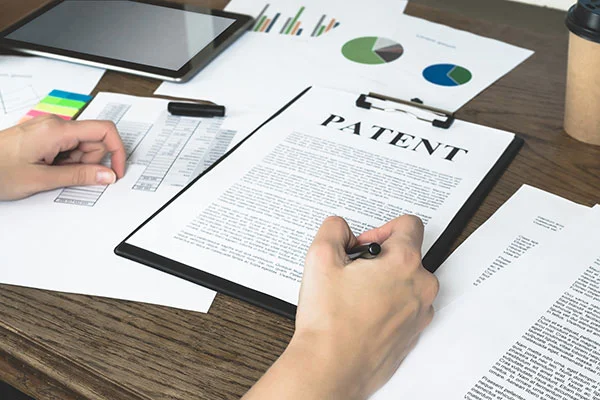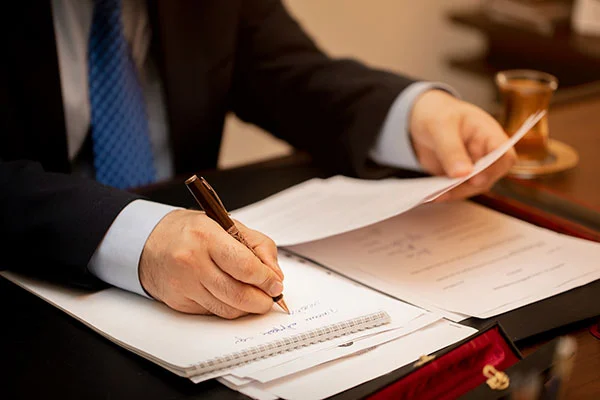About ProvisionalBuilder
If you have an invention that you would like to patent, you may want to consider applying for a provisional patent. This is a relatively low-cost alternative to a full patent application, and it also gives you a way to take legal action if someone steals your invention.
Read More


Need for a low-cost patent protection alternative
If you have a great idea, but don't have the cash to pursue a patent, a provisional patent application may be the answer to your prayers. This type of patent is one of the least expensive ways to secure a patent in the United States. A provisional patent is a way to give your idea a temporary legal semblance of legitimacy before filing a full-fledged utility patent application.
Our site has an FAQ that guides you through the process of filing a provisional patent. In order to file a provisional application, you need to submit a detailed description of your invention along with drawings. You can also choose to file it online. When filing a provisional application, you are obligated to keep the information confidential.
For many inventors, a provisional patent application is the simplest and most cost-effective way to get a patent in the United States. This is because the USPTO provides a one-year grace period after which your invention will no longer be subject to examination. As a result, you will be able to test your idea out more thoroughly and refine it if necessary. Using a provisional patent can save you money and time, which you can then spend on other aspects of your invention.
The other advantage of a provisional patent application is that it is cheaper than a standard non-provisional patent. A non-provisional patent application costs between $7,000 and $14,000, depending on the complexity of the invention. To get a more detailed estimate, you can contact a patent attorney or an agent. The USPTO has a list of attorneys and agents on its website.
The benefits of a provisional patent can be significant, especially if you are able to use your invention in a profitable manner. Some investors prefer to invest in inventors who are able to obtain a provisional patent. It can also make it easier for you to find investment capital. Another way to profit from your idea is through licensing, which allows you to earn profits by utilizing existing infrastructure.
Despite the low cost and the speedy process, a provisional patent application can't guarantee a patent. You will need to file a non-provisional patent application within 12 months of filing the provisional one. That's not to say that your provisional application will never be granted, but the chances are slim. Also, you will be paying maintenance fees for the remainder of the twenty-year term of your patent.
For those who want to see their product quickly into production, a provisional patent can help. This will enable you to test your idea, as well as determine whether or not the idea has a market.
Provisional patent application is cheaper than a full patent application
Whether you're an inventor looking for the fastest way to get your patent, or a small business owner considering filing a patent application, a provisional patent may be right for you. Not only is it much cheaper than a full patent application, but it can also save you a lot of time. Unlike a non-provisional patent application, a provisional patent application is a simple process that doesn't require an attorney. In fact, many people file their own provisional patents.
While a provisional patent application is a simpler process, it doesn't guarantee that you'll receive a patent. You'll still need to complete a non-provisional patent application within one year of filing your provisional application. After that, you can begin the examination process at the USPTO. If you're planning on using a patent lawyer to file your non-provisional application, you may need to pay a fee for that. This will depend on your patent's complexity.
Depending on the type of invention you have, the cost of a provisional patent can vary greatly. Generally, a simpler invention will cost less to patent. A more complex invention will have a higher cost. The total price will also depend on how long it takes to patent your invention.


It is important to keep in mind that even though a provisional patent application is relatively inexpensive, it does not protect you from legal issues. If you fail to comply with the correct procedures, your provisional application could be rejected. For this reason, you should hire an attorney if you need help.
Inventors who file a provisional application often underestimate the cost of the examination process. Usually, this is because they're eager to obtain an early filing date. However, the costs can add up quickly. Unless you have a firm grasp of the law, you'll end up paying more if you make mistakes. Having a lawyer look over your file can make sure you don't file something that will be difficult to defend.
Fortunately, the USPTO keeps a detailed fee schedule online. Typically, the cost of a provisional patent is two-thirds to four-fifths of the total cost of a patent application. These costs can vary widely depending on the nature of the invention and whether you're filing a patent for software, electronics, or other technologies.
An initial provisional patent application can be filed without hiring a lawyer, which can help you save money. However, hiring a lawyer is usually recommended for most people. We recommend that you use ProvisionalBuilder(R) first and then get an attorney to review and file. PatentPC.com has agreed to give ProvisionalBuilder(R) users a discount, but you can negotiate with other law firms. Whether you're trying to get a patent for your invention or you're trying to secure an investor's money for your invention, a lawyer can be a vital asset.
It's a means of recourse if someone tries to steal your invention
If you've come up with an idea and are thinking of protecting it, you might want to consider filing a provisional patent. This type of application is an inexpensive way to secure your invention. It is a way for you to test your invention before going through the entire patent process. However, it also has some disadvantages. In addition, it's not always possible to file a provisional patent early in the development of a product. So, if you have a product that you're considering filing, you might also want to consider hiring an engineer to strengthen your invention.
Another benefit of a provisional patent is that you'll have a year to develop your invention before it expires. This will give you time to test and tweak the product and work on its patentability. But if you decide to pursue a patent on the product, you'll need to convert the provisional patent into a full non-provisional patent within the first 12 months.
When you're dealing with customers, investors, or partners, you will want to protect your invention. You should consider signing a confidentiality agreement with them to ensure that they won't use your information without permission. While this method isn't 100% foolproof, it's an effective way to guard your ideas.


Before you sign any agreement, you should take a few minutes to think about what you might share with the other party. For example, you should research your potential clients, potential investors, and business partners to find out their reputation and if they have any past disputes with their current or former clients.
You should also keep detailed notes of your conversations and meetings, and follow up on any documents that you're provided. Ultimately, this information will help you build a paper trail. Aside from this, you can even photograph any documentation you receive to ensure you have a credible timestamp.
If you're working with a company, make sure that they sign a contract, as well. Likewise, if you're developing an invention for a company, be sure to include an inventor confidentiality agreement in the contract. The agreement should be tailored to the specifics of your invention, and it should provide a timeline for your disclosure of the invention.
A non-disclosure agreement is another legal contract. Often referred to as an NDA, this is a document that is signed before you reveal any information about your invention. Not only is it a legally binding contract, but it also gives you the option of suing someone who uses your information without permission.

Patent Search, Patent Databases and Free Patents Online
While not required, you should consider a patent search on your invention. The patent search is a research process that involves looking for existing patents and published patent applications to determine the novelty and non-obviousness of an invention. This process is important for inventors and businesses to ensure that their ideas do not infringe on existing patents and to assess the potential market for their invention. Patent searches can be conducted through online databases such as the US Patent and Trademark Office (USPTO) and the European Patent Office (EPO). These sites provide free patent search where you can conduct patent searches for free.
There are several free online resources for conducting a patent search. For free patents online, you can use the following:
Google Patents
Provides access to millions of patents from multiple countries, including the US, Europe, and Japan
US Patent and Trademark Office (USPTO)
Allows you to search and view patents issued by the USPTO, including full-text and images of issued patents dating back to 1790.
European Patent Office (EPO)
Offers access to patent databases and documents from the EPO, including the European Patent Register and the European Patent Bulletin.
World Intellectual Property Organization (WIPO)
Provides access to patent databases from multiple countries, including the Patent Cooperation Treaty (PCT) search system.
Once you have performed the free patent search indicating your invention is novel and non-obvious over the prior art, the next step is preparing your patent application. Getting a patent is a legal process that involves filing a patent application with a government agency, such as the United States Patent and Trademark Office (USPTO) or the European Patent Office (EPO). The process typically involves hiring a patent attorney to draft and file the application, and can be expensive.
How you can get patent applications for free?
Unfortunately, there is no way to get a patent completely for free. The process of obtaining a patent requires paying government fees, so while the process is not completely free, you can cut a significant of the cost by using free software such as ProvisionalBuilder software from our site. In addition to our free ProvisionalBuilder(R) software assistance, other free resources are available:
1. US Patent and Trademark Office (USPTO): The USPTO offers free resources for inventors, including a tutorial on the patent process, information on patent search, and a list of independent inventors' organizations.2. Small Business Administration (SBA): The SBA offers free resources for small business owners and inventors, including information on starting and growing a small business, and access to business counseling and training.3. Public libraries: Many public libraries offer resources for inventors, including access to patent databases and reference materials on the patent process.4. Online forums: There are many online forums and discussion groups dedicated to inventors and entrepreneurship, where you can connect with other inventors and get advice and support.5. University technology transfer offices: Universities often have technology transfer offices that can provide support and resources to inventors and startups, including access to patent databases and expertise in commercializing technology.



An invention is a very valuable thing to have. Getting a patent on it is the best way to protect it from other people who might want to use it. Obtaining a patent isn't easy, but it's a great way to get legal protection for your idea. With ProvisionalBuilder(R) software from Inventiv, you can do the drafting work and help yourself to patent an idea for free (of course the government fee still needs to be paid). That said, we recommend self-help with pro bono patent attorney review.
Pro bono patent attorneys
Pro bono patent attorneys are patent lawyers who offer their services for free or at a reduced fee to inventors who are unable to afford the cost of obtaining a patent.
There are several organizations that offer pro bono patent assistance to inventors, including:
The Volunteer Lawyers for the Arts
Provides pro bono legal assistance to artists, including help with patent and trademark issues.
The Legal Aid Society
Provides pro bono legal services to low-income individuals, including help with patent and trademark issues.
The Patent Pro Bono Program
A national program that connects low-income inventors with volunteer patent attorneys who can provide pro bono legal assistance.
The Inventors Assistance Center
A division of the US Patent and Trademark Office that provides information and assistance to independent inventors, including help with finding pro bono patent assistance.
It's important to note that the availability of pro bono patent attorneys may vary by location and that there may be a waiting list for services.
In sum, Inventiv ProvisionalBuilder is a cloud-based software application that supports individual inventors and startups in their patent writing process for free.